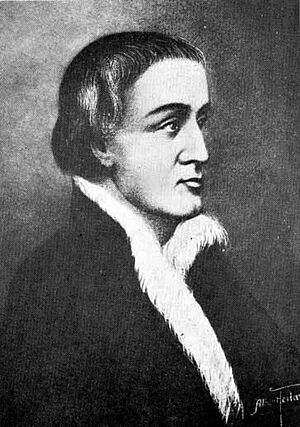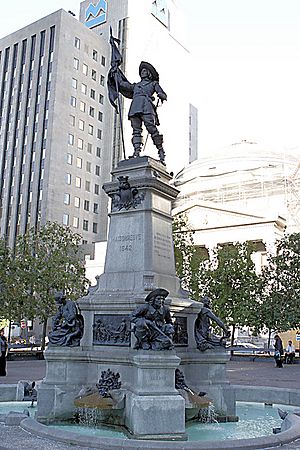Paul de Chomedey, Sieur de Maisonneuve facts for kids
Quick facts for kids
Paul de Chomedey, sieur de Maisonneuve
|
|
|---|---|

Maisonneuve's Portrait by Benjamin Sulte
|
|
| Born | February 15, 1612 Neuville-sur-Vannes (Champagne, France) |
| Died | September 9, 1676 (aged 64) Paris, France |
| Allegiance | France |
| Other work | the founder of Ville-Marie (a religious mission, in what is now Montreal, Canada) military officer |
Paul de Chomedey de Maisonneuve (born February 15, 1612 – died September 9, 1676) was a French military officer. He is famous for founding Fort Ville-Marie, which is now the big city of Montreal in Canada.
Contents
Early Life and Journey to New France
Paul de Chomedey was born in a place called Neuville-sur-Vannes in France. His family owned land nearby. He had two sisters and one brother.
Paul started his military career when he was only 13 years old in Holland. There, he also learned to play the lute, a musical instrument.
Just before he turned 30, Paul was chosen by a group called the Société Notre-Dame de Montréal. This group wanted to start a religious mission on Montreal Island in a new land called New France. Paul de Chomedey was hired to lead the settlers and keep them safe.
Founding Montreal and Early Challenges
In 1642, Paul de Maisonneuve and his group founded a settlement called Fort Ville-Marie. This was on the southern shore of the Island of Montreal. They built a chapel and a small village. A hospital, led by Jeanne Mance, was also set up. Maisonneuve became the first governor of Montreal.
The settlers had peaceful relationships with the Algonquin people, who were one of the local Indigenous tribes. The first year of the colony was calm.
In 1643, a big flood threatened the new city. Maisonneuve prayed for the flood to stop. When the water went down, he put a cross on top of Mount Royal. A cross has been there ever since.
Relations with Indigenous Peoples
The French settlers met different First Nations tribes. The Mohawk people, who were already trading with the Dutch, did not like the French trying to interrupt their trade. The Mohawk lived south of Montreal. They were a big threat to the new colony.
However, the Algonquin people stayed friendly with the French. The Haudenosaunee (also known as the Iroquois) discovered the new French settlement in 1643. Maisonneuve used his military skills to defend Montreal.
The Haudenosaunee knew the land well. They often watched and fought the French settlers from the safety of the woods. This led to a long conflict. Both groups were competing for hunting grounds and other resources.
A Brave Encounter
On March 30, 1644, things became very tense. Guard dogs warned the settlers that enemies were nearby. A group of 30 settlers went into the forest to face them. In the woods, they found 250 Haudenosaunee people waiting to ambush them.
The French had to retreat because they were so outnumbered. Maisonneuve stayed behind to make sure everyone else got back to the fort safely. A Haudenosaunee chief attacked him. Maisonneuve fired his gun twice at the chief, defeating him. He then returned to the fort, where he was celebrated as a hero.
Growing the Colony
In 1645, Maisonneuve learned his father had died. He went back to France. He was offered the job of Governor of New France, but he said no. He wanted to keep leading Ville-Marie.
Maisonneuve returned to Montreal in 1647. The wars with the Iroquois continued. In 1649, he became the godfather for the first white child baptized in the colony. Her name was Pauline Hébert.
By 1651, the Haudenosaunee attacks were so strong that Ville-Marie seemed like it might be destroyed. Maisonneuve made all the settlers hide in the fort. In 1652, the colony was so small that he had to go back to France. He needed to find 100 volunteers to come with him the next year. If he failed, Montreal would have been abandoned.
When the 100 volunteers arrived in the fall of 1653, only about 50 people were left in Montreal. One of the new arrivals was Jacques Archambault, who dug the first well on the island in 1657.
Over time, the colony grew bigger and became safer from the Haudenosaunee threat. In 1663, the ownership of the colony changed from the missionary society to the Sulpicians. New France was also declared a royal province that year. This meant the Governor General and the Sovereign Council of New France took over governing Montreal.
In October 1663, the Governor General of New France officially made Maisonneuve the governor of Montreal. But Maisonneuve disagreed. He believed only the Sulpicians, who owned the land, could appoint a governor.
In September 1665, Alexandre de Prouville de Tracy, a high-ranking official, ordered Maisonneuve to return to France. After 24 years leading the colony, he left Montreal for good.
Later Life and Legacy
Maisonneuve settled in Paris, France, and lived a quiet life. In 1671, he welcomed Marguerite Bourgeoys to his home. With his support, she had started the Congregation of Notre Dame of Montreal in 1653. This group of teaching nuns educated French and Indigenous children.
Maisonneuve died in Paris on September 9, 1676. He was buried at the Church of the Fathers of the Christian Doctrine.
Honours and Memorials
After his death, many places were named after Maisonneuve in Montreal:
- Rue Saint-Paul in Montreal was named after him. He had built his home on this street in 1650.
- Nuns' Island was once called Île Saint-Paul to honor him.
- The Maisonneuve Monument was built in 1895 in Place d'Armes in Old Montreal. It was created by Louis-Philippe Hébert. There are no real pictures of Maisonneuve, so the statue shows an imagined version of him.
- De Maisonneuve Boulevard and Rue Chomedey in Downtown Montreal are named for him.
- Maisonneuve Park, the Collège de Maisonneuve, the neighborhood of Chomedey in Laval, and a dormitory at the Royal Military College Saint-Jean also carry his name.
Gallery
-
Mount Royal Cross. The first was erected by Paul de Chomdey de Maisonneuve on January 6, 1643
-
Montreal in 1647
-
Projet Maisonneuve Monument, Canadian Illustrated News, 12 April 1879
-
Maisonneuve Monument at the Place d'Armes
Novels
- Lise Baucher-Morency / Gaëtane Breton, La périlleuse fondation de Ville-Marie, (book with musical CD) Éditions Planète rebelle (link [1]) 2017
See also
 In Spanish: Paul Chomedey de Maisonneuve para niños
In Spanish: Paul Chomedey de Maisonneuve para niños







